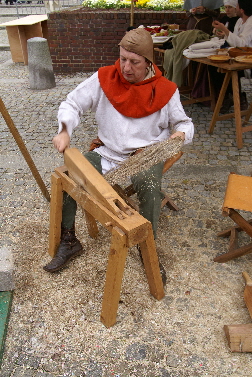|
After the flax has been retted you need to break the woody core, or boon, into small pieces. The small broken pieces fall away leaving the long and flexible flax fibres intact. The flax needs to be dry before you can break it, and it may take retted flax several weeks to dry properly. If the flax has been retted correctly and it is dry enough, the inner core will break with a snap rather than bend.
|

|
|
Using a flax break
|
|
If you have a large amount of flax to break, it is a good idea to invest in a proper flax brake. You can, however, process flax without one. A flax break is a set of hinged intersecting wooden blades, which looks like a saw-horse. It often has two blades pointing down and three pointing up, forcing the flax to bend into a W shape. A handful of flax is placed on the brake between the upper and lower arm. The upper arm is lowered crushing the stems and breaking the inner woody core. The flax is repositioned and the process is repeated until the fibres are limp and most of the boon has fallen away. This is rewarding work because you can finally see the beautiful flax fibres separating from the stem. Breaking flax generates a great deal of dust, and we recommend you wear a dust mask and do this activity in a well-ventilated area.
If you don’t have a flax brake, you can break your retted flax using just your hands. Break one stem at a time in the middle, then wiggle it and gently peel the fibres from the inner core on one side, and then on the other side. This is slow but very relaxing, the fibre comes out very clean and you don’t have to do any scutching. An alternative is to use a mallet or a rolling pin to break the flax (or even to walk over it wearing rubber boots).
Back to:-
Growing Flax,
Sowing Flax,
Harvesting Flax and
Retting Flax.
On to Spinning Flax.
Top of page
|

